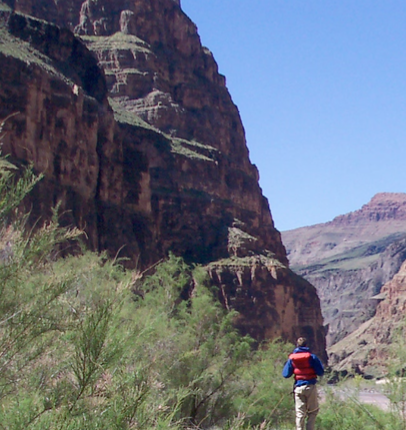Leaving Elves Chasm a small rapid greeted teaching assistant Chris Hammersmark, who had requested the opportunity to row the upcoming section of the Colorado River. Chris was focused on an adjacent, rather pointy rock which our primary guide, Danno, had alerted him to as the boat eased out into the mainstem. Flows were reaching their peak for the day of roughly 20,000 cfs, and as the current picked up our 18 foot raft we accelerated with surprising speed. There were a few seconds of silence as Danno and I watched the boat begin to descend towards a moderately sized hole. Patience was replaced with trepidation as the frothing water approached our boat. “You’re going to want to square up to that,” Danno pointed out sagely. Chris started rowing harder, using a series of short chopping strokes trying to rotate the boat. I grabbed cam straps on the rear drybags and clamped down tightly as the boat finally swung fully into the hole, snapping the back of the boat like the end of a bloated yellow whip. As the bow emerged downstream I thankfully relaxed my grip and began to reflect on the many surprises rafting the Colorado has presented me with.
Having also had the opportunity to row the same day, I felt a certain degree of sympathy for Chris, who was unaccustomed to the extraordinary power of the Colorado River. For the many seasoned boaters who run the Grand Canyon every year there are a number of differences from the smaller more typical whitewater runs most of us come from. First and foremost is the size of the Colorado River (roughly 30 feet at thalweg) and the sheer volume of water that is passing down the mainstem. What may appear to be fairly calm water belies a powerful force. I have seen eddy lines routinely stretch 30 feet or more from the main current to return flow. This region is rife with boils and gyres which toss the our 18 foot heavily laden rafts around like bathtub toys. A typical Sierra Nevada boater can appreciate the sharp eddy lines of most smaller rivers, which allow entry at almost any point and are equally accessible to escape. The Colorado River demands a much more finely tuned eye, with narrow windows for entry and exit at the
top of eddies. It is possible row against the return flow, but the current is so strong that even pulling out of the bottom of eddies can prove to be an exhausting experience. When I found myself accidentally pulled into an eddy adjacent to the bottom of a small wave train in the morning I foolishly decided to pull my way back out of the base. It took several minutes of hard rowing against the current to escape without returning to the top of the eddy. In the meantime the rest of our seven boat armada had moved downstream what appeared to me to be at least a half mile.
While the technical aspects of most Colorado River rapids seem somewhat diminished relative to a run such as Cherry Creek, they pose a unique set of new problems to clean runs. Thanks to the enormous size of the Colorado River, rapids form standing waves large enough to surf an 18 foot raft without difficulty. These same waves are constantly are jostling the bow of the boat, pushing it off course and forcing correction. Flipping boats is a perpetual concern, especially given the water temperature in March. Crystal Rapid proved this point with two powerful holes in the upper Chute that were sticky enough guides ran it without shirts or pants, to make swimming easier. Even the small constriction below Elves Chasm was strong enough to flip a full sized raft that was not properly aligned at entrance. This is often concealed again by the size of the Colorado River which makes sizable holes appear insignificant. Standing on the Bright Angel trail on the day of put in a veteran rapid shooter was convinced our rafts were 14 foot boats rather than the full 18 footers they were, another trick on the eye played by such a large river.
To avoid being sucked into the Colorado River’s super eddies or thrown into obstructions requires a buildup of momentum at the top of and throughout the rapid. Rowing in rapids through large haystacks is challenging enough, but with piles of gear and passengers whipsawing back and forth at the bow it becomes downright daunting. I expected clean runs through the small wave trains I ran, and repeatedly found myself struggling to avoid being pulled into eddies and keep my line.

As Chris rowed a calm stretch below our close call to the next field site, I noticed his strokes began to lengthen, a sign of comfort on the river. Suddenly the boat lurched to the left and Chris’s left oar was torn from his hand and pinned against the raft tube. He recovered quickly and began catch up with the leading boats. On the whole I was impressed with Chris’s performance for someone who had relatively little time rowing in the Grand Canyon. The Colorado River requires constant vigilance that doesn’t come naturally, even on the flats. Traveling with a well seasoned guide it is often easy to forget this; they make it look so easy.
